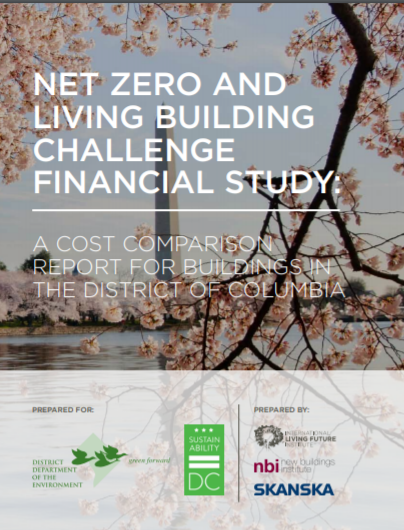Net Zero and Living Building Challenge Financial Study: A Cost Comparison Report for Buildings
Report / April 16, 2014 / Getting to Zero

The Net Zero and Living Building Challenge Financial Study investigates the anticipated cost differential between a set of three reference buildings designed to the LEED Platinum standard and those same three buildings conceptually designed for deep energy efficiency, net zero energy, net zero water and adherence to the Living Building Challenge™. It summarizes the cost premium range for each building type, uncovers challenges associated with the large size of commercial buildings in the District of Columbia and provides policy recommendations for addressing them.
For the study, New Buildings Institute (NBI) teamed up with the International Living Future Institute (ILFI ) and Skanska to conceptually transform three LEED v3 Platinum designed buildings in the District of Columbia to net zero energy, net zero water and Living Buildings. The LEED Platinum reference buildings represent three commonly developed types in the District: office new construction, multifamily new construction, and office renovation. All were either in design or recently completed, and the team benefited from recent cost estimates and detailed information about building characteristics and systems. A set of energy conservation strategies and rainwater harvesting techniques were applied to each building to arrive at reduced energy and water usage before photovoltaics (“PVs”) and water reuse strategies were applied.
However, incentivizing the creation of ultra-water and energy efficient buildings that provide some of their own resources puts the District of Columbia in a strong position to be a net zero water and energy city in the future, as technology advances and as solutions the neighborhood scale are developed. Costs for getting to zero are difficult to distinguish from overall project costs. The team conducted an analysis to identify incremental cost premiums for deep energy and water conservation as well as for photovoltaic and water reuse systems that would bring a project to net zero. The cost premium for energy efficiency was approximately 1-12% depending on building type. This rose to 5-19% for net zero energy. The analysis made clear that if the owner has sufficient tax appetite, tax credits and renewable energy credits make the return on investment approximately 30%, whereas the return on investment for energy efficiency alone was in the range of 5-12%.
